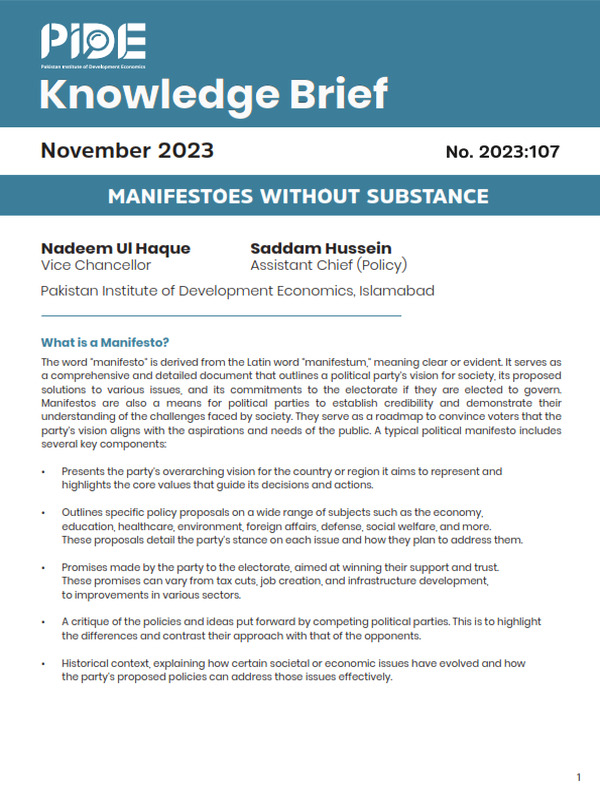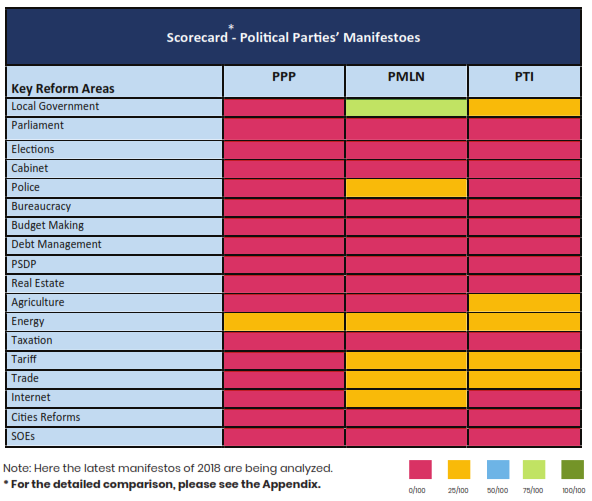
Pakistan Institute of Development Economics
- Home
Our Portals
MenuMenuMenuMenuMenuMenuMenu - ResearchMenuMenuMenuMenuMenuMenuMenu
- Discourse
- The PDR
- Our Researchers
- Academics
- Degree Verification
- Thesis Portal
- Our Portals
Manifestoes Without Substance
What is a Manifesto?
The word “manifesto” is derived from the Latin word “manifestum,” meaning clear or evident. It serves as a comprehensive and detailed document that outlines a political party’s vision for society, its proposed solutions to various issues, and its commitments to the electorate if they are elected to govern. Manifestos are also a means for political parties to establish credibility and demonstrate their understanding of the challenges faced by society. They serve as a roadmap to convince voters that the party’s vision aligns with the aspirations and needs of the public. A typical political manifesto includes several key components:
- Presents the party’s overarching vision for the country or region it aims to represent and highlights the core values that guide its decisions and actions.
- Outlines specific policy proposals on a wide range of subjects such as the economy, education, healthcare, environment, foreign affairs, defense, social welfare, and more. These proposals detail the party’s stance on each issue and how they plan to address them.
- Promises made by the party to the electorate, aimed at winning their support and trust. These promises can vary from tax cuts, job creation, and infrastructure development, to improvements in various sectors.
- A critique of the policies and ideas put forward by competing political parties. This is to highlight the differences and contrast their approach with that of the opponents.
- Historical context, explaining how certain societal or economic issues have evolved and how the party’s proposed policies can address those issues effectively.
Objective
The primary objective of a manifesto of a political party is to present a clear and persuasive case to the voters about why they should support the party in an upcoming election. It aims to showcase the party’s ideology, principles, and policy priorities, providing a blueprint for governance if the party is elected to power.
Significance
The significance of a manifesto of a political party cannot be overstated. It plays a crucial role in shaping public opinion and informing voters about a party’s platform. Voters often use manifestos as a basis for assessing whether a party’s proposed policies and ideas align with their own values and interests. A well-crafted manifesto can have a significant impact on an election campaign. It can rally party supporters, attract swing voters, and sway undecided individuals. Additionally, once a party is elected, its manifesto serves as a benchmark against which its performance and progress can be measured. However, it is essential to note that not all parties adhere strictly to their manifesto once in power due to practical challenges, changing circumstances, and compromises during coalition governments.
PIDE’s thoughts on a Manifesto
In the grand theater of democracy, a manifesto is the opening act that captivates minds, fuels discussions, and rallies support. It stands as a testament to a party’s integrity and ability to forge a path forward. The significance of a political party’s manifesto is akin to the foundational blueprint of a grand architectural masterpiece. It embodies the very essence of a party’s ideals, aspirations, and commitment to its constituents. Just as a skilled architect meticulously plans each detail before constructing a magnificent edifice, a manifesto outlines the principles, policies, and proposed pathways that guide a political party’s journey. Everything in the realm of politics starts with a manifesto. Much like the first brushstroke on a canvas, a manifesto shapes the contours of a party’s narrative and sets the tone for its engagement with the electorate. Moreover, a manifesto is a covenant of accountability. By pledging specific courses of action, a party makes a solemn promise to its people. This binding commitment holds a party answerable to its stated goals and, in turn, empowers the electorate to demand transparency and efficacy in the realization of those promises. Thus, everything, from the shaping of policies to the forging of a nation’s destiny, starts with the resolute words etched within a manifesto.
Pakistan’s Case
Political manifestos of political parties in Pakistan vary in nature and quality. Some manifestos are well-crafted documents that outline a party’s vision, policy goals, and plans for governance. However, these manifestos seldom include detailed proposals, which provide a clear roadmap for how the party intends to address these issues if elected to power. This is why political manifestos are often criticized as being mere promises without a concrete plan for implementation. Manifestos of almost all political parties in Pakistan lack specificity, feasibility, or practicality, leading to skepticism about the party’s intentions and ability to deliver on its commitments.
So, for this reason, we have attempted to draw a comparison of 2018 manifestos amongst three mainstream political parties that are front-runners is formulating governments during last three tenures, against the benchmark of “What PIDE proposes” in parallel.
How did we calculate?
PIDE has been proposing reforms in various dimensions for quite a long now. These targeted reform proposals are based on years of research, evidence and are in line with the global best practices. So, we have picked some key issues/sectors which we at PIDE think are fundamental in nature. This means that if we are to kick-start the reform process, addressing these primary issues comes first, acting as a bedrock for further comprehensive reforms. We summarized PIDE proposals in four points for each theme, having equal weightage for each point i.e. 25%, making it 100% for all four points. We then compared it with what each political party is proposing against the same theme. If their manifestoes proposed one of the points that PIDE proposes then the score will be 25/100 and if their proposals included all that PIDE proposes, then that manifesto will get full marks i.e. 100/100. It is pertinent to note that, manifestoes are being evaluated on actual reform intervention, not mere promises, slogans and sweeping statements. For instance, strengthening local government is merely a promise and scored as zero. In contrast, allowing the property tax regime to serve as the primary revenue generator for local government is a concrete point. Thus, this point had been given a 25 score.
Analysis
As evident from the scorecard, all three political parties do not do any homework, except for a couple of themes – in those too, the score is not remarkable. One can only find big slogans, sweeping statements, and hollow promises. There is no clear road map, no concrete intervention proposals, no blueprint for reform implementation.
As shown in the scorecard, PPP scored zero in 17 indicators, PTI in 13 and PML-N in 12. Overall, the three major political parties scored less than 20%, which means that they talk about or have some solid ideas about only 20% of the key economic and policy issues of Pakistan. Further dissecting the figure 20% tells us out of the country’s key issues, only 12% of these find space in the PML-N manifesto, 7% in the PTI manifesto and 1.5% in PPP
One wonders, how and on what these political parties compete with one another. A look at the above scorecards would imply that more or less all three parties are the same, as far as the manifestoes are concerned. It is a point to ponder, why the public is divided over more or less alike political parties, as reflected from the manifestoes. It is time to take manifestoes seriously, and compel our representatives to focus on manifestoes and add issues of concern to common people, along with proposing comprehensive proposals and clear-cut implementation strategies. This would allow the public to compare the manifestoes in a better way and consequently would do better in voting most deserved political party – the one having done proper homework, knowing what to do if they come into power and if they do, the implementation can start immediately. This would also save time from making misfit task forces to propose reforms that usually mean nothing but optics – only bureaucratic and administrative shuffling, whereas reform means setting the fundamentals right.
Conclusion
The superficiality of Pakistani political parties’ manifestoes, particularly the economic side of it, is a technical shortcoming that has far-reaching implications for the country’s economic development. The absence of quantitative targets, shallow policy proposals, and neglect of structural reforms, trade, and investment strategies, as well as human capital and innovation, signify an alarming lack of technical rigor. A more evidence-based, quantifiable, and technically detailed approach is imperative to tackle Pakistan’s intricate policy challenges effectively and drive sustainable economic growth.
PIDE hopes that insights from this knowledge brief will make political parties ponder over the upcoming manifestoes. Thus, anticipating that the latest manifestoes will not be just hollow ones, but having concrete and targeted blueprints for reforms to put Pakistan on the right track.




